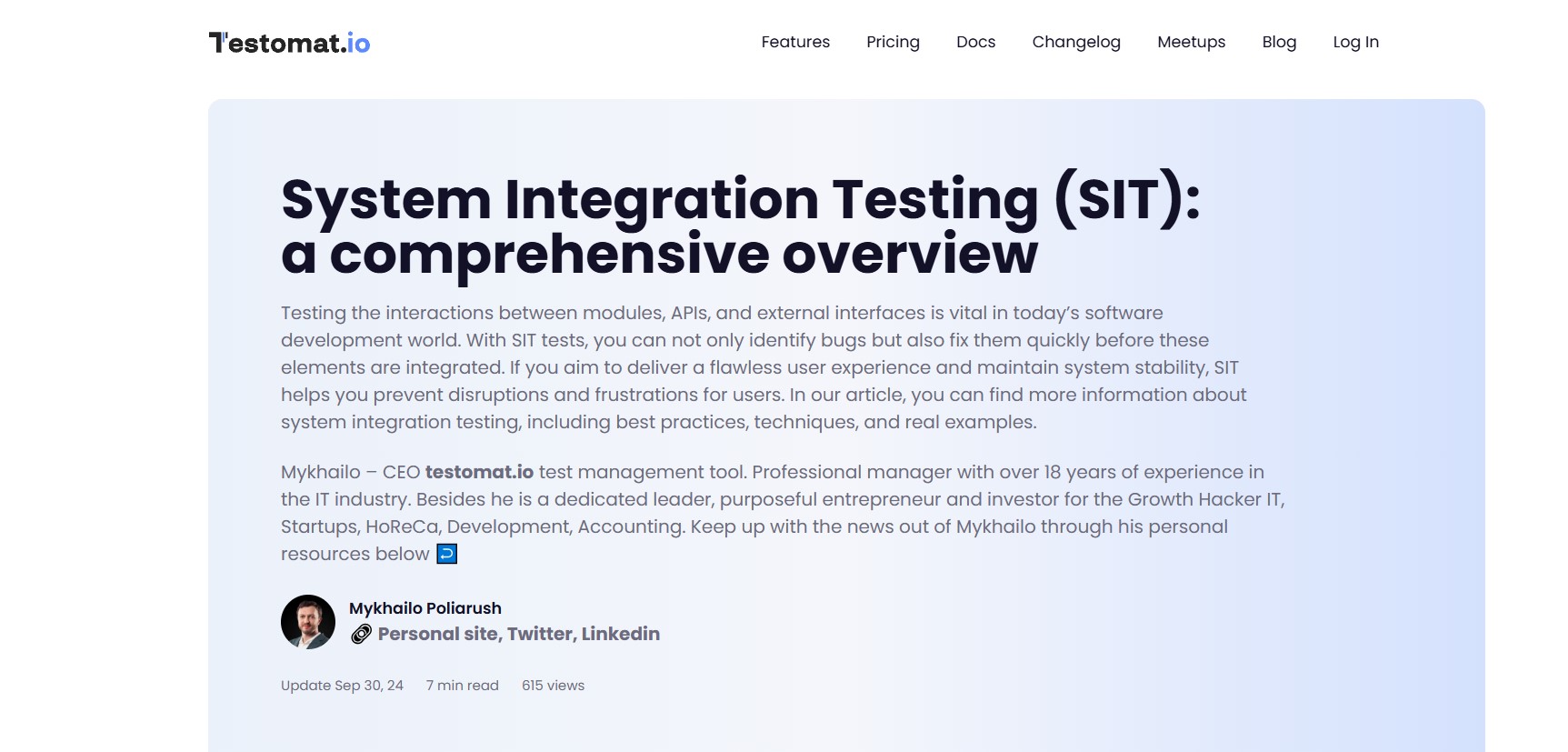System Integration Testing: The Key to Seamless Software Performance

Strong 8k brings an ultra-HD IPTV experience to your living room and your pocket.
System integration testing, commonly abbreviated as sit testing, plays a critical role in the software development lifecycle. It ensures that individual software modules or components work together as expected when integrated into a complete system. Unlike unit testing, which focuses on the smallest pieces of code, sit testing verifies the communication, data flow, and functional correctness across different parts of the software system and external interfaces. This testing phase is essential to detect any defects or inconsistencies that could impact the overall application stability and performance before releasing it to end users.
The importance of sit testing cannot be overstated. Modern software systems are often complex and composed of various subsystems developed independently by different teams or vendors. Without proper system integration testing, these components may not interact correctly, leading to errors that are difficult and costly to fix later. Sit testing helps identify these integration issues early, reducing risks and improving software quality. It validates that all integrated modules function cohesively according to the specified requirements, which ultimately enhances user satisfaction and business value.
When conducting sit testing, testers focus on scenarios that involve multiple modules working in unison. These scenarios include verifying data exchanges between systems, ensuring communication protocols are correctly implemented, and checking that external interfaces such as APIs or third-party services behave as expected. The process involves designing test cases that simulate real-world interactions and workflows across the integrated components. A thorough sit testing strategy often covers functional, performance, security, and usability aspects to ensure comprehensive validation.
Choosing the right approach for sit testing is critical. It typically follows after successful completion of unit and integration tests. Common methods include top-down, bottom-up, and big bang integration testing, each with its advantages and challenges. In top-down testing, higher-level modules are tested first, gradually integrating lower-level modules. Bottom-up testing starts with testing lower-level components before integrating higher-level modules. The big bang approach tests all integrated components simultaneously, which may save time but can complicate debugging. Selecting the best method depends on the project’s complexity, team structure, and testing goals.
One of the main challenges in sit testing is managing dependencies and ensuring the environment mirrors the production setup as closely as possible. Differences in configurations, network settings, or hardware can cause tests to fail or produce misleading results. Testers need to establish a stable and controlled test environment where all integrated components are deployed correctly and accessible. Additionally, automated testing tools can support sit testing by providing repeatable and efficient test execution, especially for regression testing when frequent system changes occur.
Effective sit testing requires clear communication and collaboration between development, testing, and operations teams. Testers must understand the system architecture, integration points, and business workflows to design meaningful test scenarios. Developers should provide documentation and assist in resolving issues discovered during sit testing. Continuous integration and continuous deployment (CI/CD) pipelines can facilitate regular integration testing by automating build, deployment, and testing processes, enabling faster feedback and higher software quality.
The benefits of thorough sit testing extend beyond defect detection. It improves overall system reliability, reduces downtime, and ensures compliance with regulatory requirements. By validating that all components work together smoothly, sit testing supports scalability and maintainability of software systems. It also enhances the user experience by preventing unexpected failures and performance bottlenecks. Organizations that invest in robust sit testing practices can achieve faster time-to-market, lower maintenance costs, and stronger customer trust.
For professionals seeking to deepen their understanding of system integration testing, resources such as detailed articles and tutorials can provide valuable insights and practical tips. One such resource is the comprehensive guide available at [https://testomat.io/blog/system-integration-testing/](https://testomat.io/blog/system-integration-testing/), which covers all aspects of sit testing in depth. This guide explains the methodology, best practices, tools, and real-world examples, making it an excellent reference for testers, developers, and project managers alike. Access this site to enhance your knowledge and improve your testing processes.
The focus keyword sit testing is central to mastering software quality assurance in integrated environments. By emphasizing sit testing in your development workflow, you can ensure that your applications function as intended across all components and external systems. Visit [https://testomat.io/blog/system-integration-testing/](https://testomat.io/blog/system-integration-testing/) to explore the topic further and leverage expert advice for optimizing your sit testing strategies.
System integration testing is not just a procedural step but a strategic investment in delivering robust software products. As technology evolves and systems become more interconnected, the complexity of integration increases, making sit testing indispensable. Comprehensive sit testing helps identify interface mismatches, data format errors, timing issues, and other subtle defects that might not surface during isolated module testing. Such early defect identification saves significant time and resources by avoiding costly fixes post-deployment.
Organizations aiming to excel in software delivery should adopt a systematic approach to sit testing. This includes defining clear test objectives aligned with business requirements, selecting appropriate test data, employing automation where feasible, and continuously refining test cases based on feedback and changing system dynamics. Additionally, integrating sit testing results into project dashboards and quality metrics promotes transparency and informed decision-making across teams.
In conclusion, sit testing is a fundamental practice for ensuring that all parts of a software system interact harmoniously to deliver expected outcomes. It bridges the gap between isolated module testing and full system validation, enabling the detection of integration flaws before they impact users. Leveraging comprehensive resources like the guide at [https://testomat.io/blog/system-integration-testing/](https://testomat.io/blog/system-integration-testing/) empowers teams to implement effective sit testing processes, ultimately contributing to the development of reliable, high-quality software solutions.
Visit [https://testomat.io/blog/system-integration-testing/](https://testomat.io/blog/system-integration-testing/) to learn more about sit testing and discover practical advice, tools, and techniques that can elevate your software testing efforts. Mastering sit testing is essential for anyone involved in software development and quality assurance who wants to achieve seamless system integration and superior product performance.
Note: IndiBlogHub features both user-submitted and editorial content. We do not verify third-party contributions. Read our Disclaimer and Privacy Policyfor details.


